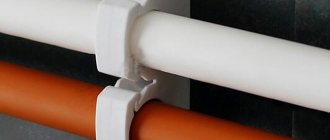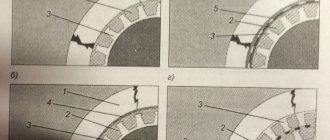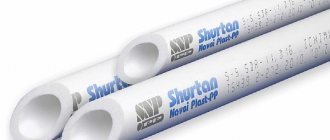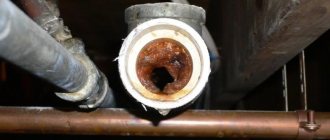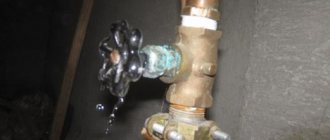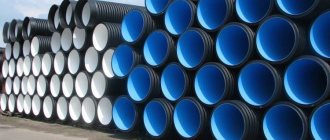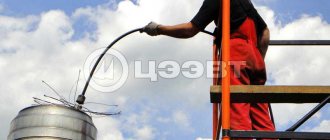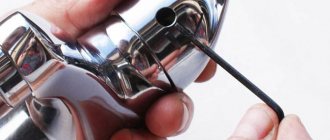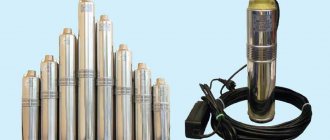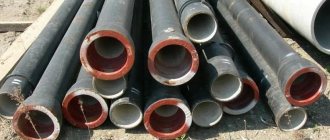Steel water pipes
Traditionally, it was believed that water pipes, fittings, and equipment made of black steel (GOST 3262-75) provide a sufficiently long standard service life. Departmental construction standards, approved back in 1988, provided for an accident-free service life of utility network elements of 10-15 years. The disadvantages of conventional (black) steel were not taken into account, which led to a large number of emergency situations in the water supply and wastewater system.
Steel water pipes
The main advantage of steel pipes, strength, has confirmed its effectiveness exclusively in high-pressure pipelines that supply water to objects. When laid in the ground (channel method) and on the surface, water pipes with a sufficiently large internal flow area rarely fail due to the deposition of insoluble compounds. Metal corrosion is the main reason for reducing the service life of such networks.
Steel pipes used in the internal water supply system of apartment buildings, based on technical and economic feasibility and the current regulations SNIP 2.04.01-85 *, have a smaller diameter and a large number of connections. These characteristics, combined with the poor quality of water circulating in the systems, contribute to a reduction in the standard service life of water pipes.
Standard service life of water supply pipelines
The main document establishing the standard service life of utilities in a residential building is VSN (departmental building codes) number 58-88, adopted in 1988. They regulate the timing of maintenance, reconstruction and repair of buildings. The document regulates the procedure for repair and reconstruction of buildings. Appendix No. 3 to the document provides the following figures: What factors limit the service life of VGP pipes without anti-corrosion coating: Service life of steel structures
Not a single facility can be built without pipelines; these durable and strong profiles made from a wide variety of materials are used in almost all sections of the construction industry. A variety of materials are used to make pipes, and their service life depends not only on the properties of these materials, but also on the chemical activity of the medium transported through the pipes and in contact with the inner surface. The service life of pipes is also directly dependent on the temperature indicators of both the media passing inside and the conditions in which the structures operate.
Galvanized water pipes
The service life of galvanized water pipes in individual buildings and apartment buildings, according to VSN (departmental building codes), is longer than pipes without anti-corrosion coating.
Galvanized water pipes
Based on SNIP, “galvanization” can be used in the following engineering structures:
- Eyeliner, cold water supply risers. Estimated service life is 30 years.
- Closed hot water systems. Maximum service life, 20 years.
- DHW, with an open heating system. Service life up to 30 years.
In practice, the period of trouble-free operation is significantly shorter, due to clogging of the internal flow section of the pipes, due to the intermittent dynamics of the movement of water through the pipes. Another reason for the rapid failure of galvanized water pipes is a violation of the connection technology.
It is not recommended to make connections using welding. Burnout of zinc leads to an accelerated process of corrosion formation at the joints.
Service life of metal water supply pipes: Standards | My well
No, this is not the Alien's digestive system. Just the insides of an old plumbing
How long do metal pipes last for water supply? Today we have to rummage through the regulatory documentation to find the answer to this question and find out why the service life of pipelines is being reduced. Let's get started.
Announce the entire list
First, let's remember exactly what types of metal pipes are used in cold and hot water supply systems.
Actually, there are currently only four of them:
- Black steel (water and gas pipes GOST 3262-75);
- Galvanized steel, produced to the same standard;
- Copper;
- Corrugated stainless steel.
It’s interesting: just a few decades ago, cold water supply lines were massively laid with cast iron pipes. However, now they have been almost completely replaced by pressure polyethylene ones.
A cast-iron water supply system, built more than two centuries ago, feeds the famous fountains of Peterhof
Black steel
Steel rusts. It rusts especially quickly with prolonged contact with water. That is why the service life of steel risers and connections laid down in the regulatory documents, frankly speaking, is not amazingly long.
The main document establishing the standard service life of utilities in a residential building is VSN (departmental building codes) number 58-88, adopted in 1988. They regulate the timing of maintenance, reconstruction and repair of buildings.
The document regulates the procedure for repair and reconstruction of buildings
Appendix No. 3 to the document provides the following figures:
| Engineering system element | Standard service life, years |
| Riser or cold water supply from gas pipes | 15 |
| A riser or hot water supply from gas pipes in a building with a closed heating system (without taking hot water from the heating system) | 10 |
| The same, in a building with an open heating system (DHW is taken from the heating circuit) | 15 |
| Heated towel rails in the DHW system | 15 |
Destructive factors
What factors limit the service life of VGP pipes without anti-corrosion coating:
| Image | Description |
| Steel water supply risers. The first fistula that caused the ceiling to become wet appeared in the ceiling | Corrosion. Rusting of the pipe is accelerated by a damaged outer layer of paint, frequent shutdowns of the water supply (in this case, the unpainted inner surface of the pipe is in contact with air with high humidity) and poor ventilation in the bathroom (read: consistently high humidity). The first fistulas appear on longitudinal welds (VGP pipes GOST 3262 are electric welded), on threads where the thickness of the pipe walls is minimal, and in ceilings where the surface of the pipes is not ventilated and (in the case of cold water risers) is continuously wetted by the condensate falling on them. |
| Lime deposits and rust have almost completely blocked the gap in the water pipe | Overgrowing of pipes with deposits (primarily lime salts) and rust.
|
| The diameter of steel risers is selected taking into account the reduction in pipe capacity due to deposits | Pipeline diameter. The larger the internal cross-section of the pipe, the longer it maintains acceptable throughput. |
| The thicker the wall, the longer the pipe can resist corrosion. | Wall thickness. According to GOST 3262, ordinary, reinforced and lightweight pipes are produced. It is clear that those reinforced before the first through fistulas appear will last longer. |
Please note: a steel line overgrown with deposits can often be cleaned with a steel cable or string. Even more effective destruction of deposits is ensured by chemical flushing of the water supply system: an alkaline or acidic environment dissolves lime and iron oxides.
Chemical flushing can transform old plumbing
Actual service life
In the author’s memory, the minimum trouble-free service life of a steel cold water supply system in a new building was only 10 years.
The house was built and delivered shortly before the collapse of the Union, in conditions of austerity on building materials and the actual inoperability of Soviet norms and standards.
Lightweight VGP pipes, purchased for reasons of economy, quickly and en masse began to leak at welded joints and threads.
By the way: despite the same standard service life specified for black steel pipes in cold water and hot water systems, cold water pipes fail much faster. They rust intensively due to the condensation that falls on their surface during the hot season and quickly become overgrown with deposits due to the lack of additives that dissolve lime and rust in drinking water.
The photo shows the typical condition of a cold water supply riser after 20 years of service.
The oldest engineering systems made of black steel have been in service for more than half a century.
In addition to the large thickness of the pipe walls, their longevity is facilitated by:
- Low humidity levels;
- No condensate on cold water pipes;
- Periodic painting of risers and liners;
- Low content of mineral salts in water.
Standard service life
We can find data about him in the same VSN 58-88:
| Engineering system element | Standard service life, years |
| Riser or liner in a cold water supply system | 30 |
| Riser or hot water supply in a house with a closed heating system | 20 |
| The same, in a house with an open heating system | 30 |
The photo allows you to compare the condition of black pipes and galvanized pipes after storage under the same conditions
Copper
The next metal on our list is copper.
Copper water supply: stylish and durable
How long can these metal hot water pipes last? There are no regulatory documents establishing specific service periods. Manufacturers promise a vague “50+” years.
In practice:
- The oldest copper water pipes have been in service for more than a century and are still in perfect condition;
- Copper does not degrade over time, is not subject to corrosion and is only afraid of significant mechanical stress: the metal is very plastic, and the pipe walls are only about a millimeter thick.
Corrugated stainless steel pipe
How long will corrugated stainless steel last in a water supply?
According to one of the leading manufacturers, the Lavita company - indefinitely. Lavita explicitly states that its products have an unlimited service life.
Characteristics of Lavita corrugated pipes. Please note maximum pressure and service life
However: silicone seals in press fittings will still have to be changed after 30 years. This work is not difficult: the fitting can be disassembled to replace the seal with a pair of adjustable wrenches in 30-60 seconds.
What is the actual service life of stainless steel in water supply cannot yet be said simply because of the limited time of its operation.
Plastic pipes
Plastic pipes (polymer) used for the installation of internal water supply systems do not contradict established construction standards (SNiP). They can be used when laying external networks in a channel manner (in the ground) and on the surface, with additional thermal insulation.
The service life is practically unlimited. The polymer used completely eliminates the possibility of corrosion (exception: threaded fittings) and reduction of the internal cross-section due to contamination with insoluble compounds. The main reason for the failure of water pipe systems in individual and apartment buildings is poor-quality installation of hot water supply systems (open, closed).
The use of material intended exclusively for cold water supply in hot water supply systems leads to natural destruction of hot water supply lines.
The service life of water pipes in an apartment building or in individual individual buildings depends on the material of the pipes, the quality of installation of communications and the quality of the water used.
Source
Standard service life of external steel water supply pipes
In this article we will look at several types and characteristics of pipes for home plumbing. Modern pipe manufacturers use a range of structural materials in the manufacture of their products. However, currently, only plastic or metal pipes are used in water supply systems.
The documents for the pipe according to GOST 3262-75 do not provide a service life. When using galvanized steel pipes in accordance with GOST 3262-75, their service life will depend on the operating conditions. Duration of operation before major repairs (replacement)": Cold water pipelines from galvanized pipes - 30 years (residential buildings), 25 years (municipal facilities).
Types of pipeline
Several types of metal products are used in heating and water supply systems:
- black steel pipes - steel of different grades is used in production, but it is not corrosion resistant. Such rolled metal products require additional protection - painting, for example;
- galvanized steel pipes - products are coated with a layer of zinc. The latter forms a galvanic couple with iron and is destroyed by an electrochemical reaction, protecting the steel from corrosion. Obviously, the service life according to SNiP and GOST for such a model is much longer;
- stainless steel – alloys with the addition of nickel and chromium. Depending on the size of the alloying additive, steel can be resistant to corrosion under normal conditions, is characterized by increased resistance, which allows use in sea water, for example, and also does not oxidize under the influence of not only moisture, but also high temperature. The product does not need protection, however, its cost is noticeably higher;
- copper - rare, but used in domestic conditions. They are distinguished not only by their resistance to corrosion, but also by their disinfecting properties.
Each option from the list can be used for water supply, gas pipelines, heating, and not only water, but also steam. However, their service life will vary.
Announce the entire list
First, let's remember exactly what types of metal pipes are used in cold and hot water supply systems.
Actually, there are currently only four of them:
- Black steel (water and gas pipes GOST 3262-75);
- Galvanized steel, produced to the same standard;
- Copper;
- Corrugated stainless steel.
It’s interesting: just a few decades ago, cold water supply lines were massively laid with cast iron pipes. However, now they have been almost completely replaced by pressure polyethylene ones.
A cast-iron water supply system, built more than two centuries ago, feeds the famous fountains of Peterhof
All about galvanized water pipes: types, standard sizes and weights, GOST table
The main disadvantage of iron bends is their rapid rusting. To protect the metal from rust, it is galvanized. The steel surface is coated with a layer of zinc, resulting in the formation of a protective film that does not allow oxygen to reach the metal and prevents the corrosion process.
Hello, dear reader! Galvanized water pipes, due to their properties, occupy a special place in the pipe products market. They are quite widespread and therefore we propose to take a closer look at their characteristics and application possibilities.
- Hot-dip galvanizing is performed by placing the workpiece in a container with zinc melted to 450°.
- Galvanic - during the electrolysis process, zinc from the electrolyte is evenly deposited on the surface of the product and forms a thin protective layer.
- Diffuse galvanizing is the treatment of the workpiece with zinc vapor at temperatures up to 450 degrees in special closed containers. Zinc particles penetrate the steel structure and form a durable coating with a thickness of up to 50 microns. As a result, the galvanized product, in addition to anti-corrosion properties, also receives electrochemical protection.
Rust should not appear in galvanized pipes. Sediments and other debris do not linger on their smooth walls. However, if the pipeline taps are not opened completely, then the flow does not have time to wash away the waste coming from the central network into the home system. Gradually, the accumulation of contaminants is cemented with lime and iron oxide and a plug appears.
One solution to this problem is to install a coarse filter. With proper installation and proper operation, galvanized channels can last over 50 years. However, in this regard, they are inferior to corrugated stainless steel pipes, analogues made of polypropylene, the service life of which is positioned to be even longer. The differences between the standards lie in some standard sizes and operating pressure indicators that standardize the documents.
Thus, products with a diameter of up to 102 mm, manufactured according to the latest two standards, must withstand 6 MPa and 3 MPa hydraulic pressure.
Service life of steel water supply pipes according to GOST
- practically not subject to corrosive destruction;
- has high resistance to chemically aggressive substances;
- from an environmental point of view it is absolutely safe;
- has the highest mechanical strength and heat resistance;
- the coefficient of thermal expansion of steel is 1.5 times lower than that of copper, and 6 times lower than that of plastics, which allows such pipes to be laid directly in the floors.
- corrosion and the tendency to accumulate biological deposits, resulting in a decrease in the throughput of the system;
- the need for systematic preventive maintenance (painting, cleaning the internal surface);
- when laying external networks, the use of special equipment is required;
- installation requires significant time and labor costs;
- relatively short service life of steel water pipes (25–30 years).
Black steel for water pipe
Alas, this option is not particularly durable. Even with the most careful painting and care, they will rust over time. The fact is that after the construction of communications, individual fragments turn out to be inaccessible, and it turns out to be impossible to update the paint, for example.
In addition, black steel loses its smoothness quite quickly. And this leads to the fact that the water-gas or heating pipe “overgrows” quite quickly: first very small debris and salt deposits are retained on the unsmooth surface, and then increasingly larger particles of rust, fibers, and lime deposits. The rate of sediment accumulation is directly proportional to water hardness.
Constant contact with moisture - in the bathroom, for example, in the toilet, leads to faster destruction of the material, which is reflected in SNiP standards. Here the weak link is often the seams: the first fistulas appear precisely on the welds and threads, where the wall thickness decreases.
Standard operating times are:
Features of communications using steel pipes
The massive use of steel water pipes in Soviet times and in modern Russia is explained by their availability, manufacturability and the quite acceptable standard service life of pipelines made from them, providing water supply and sewerage drainage in apartments of multi-storey buildings. Rolled metal can withstand loads resulting from pressure surges.
However, metal pipes also have disadvantages, due to which today they are increasingly being replaced by polymer analogues. The main one is the limited service life of steel pipelines; the average lifespan of such water supply systems is about 20 years. It fluctuates depending on various factors, which we will discuss below.
Metal-plastic and polymer pipes last much longer. For pipelines made from these materials, the service life is 50-80 years.
The main disadvantage of metal is the appearance of corrosion upon contact with water. The inner surface of the pipes gradually ceases to be smooth, as small pockets of rust form on it. In such areas, salt deposits, which are always present in tap water, accumulate over time. As a result, pipelines lose their original performance in two ways:
- the metal becomes thinner as a result of gradual rusting. When the wall thickness becomes critical, a breakthrough occurs. If signs of such wear and tear are not noticed in a timely manner, a serious accident may occur;
- The flow area of the pipe is reduced due to overgrowing with salt deposits. This is a fairly lengthy process, but in houses built several decades ago, management organizations regularly face its consequences. It is dangerous not only to completely block the pipe passage, but also to significantly narrow it. If a large enough piece of rust comes off the wall, it can completely block the hole through which water previously passed.
Metal pipes conduct heat well and at the same time only slightly change their dimensions when the temperature of the transported water changes. This allows you to lay them in walls if necessary.
Among the disadvantages of metal pipelines, it is worth noting the significant costs of installation work. To arrange communications, gas welding equipment is required. In addition, the significant weight of the pipes imposes additional difficulties on the process of transporting and lifting them to the work site in a high-rise building.
Installation rules
Couplings, tees and other fittings used in assembling a galvanized pipeline must be made of galvanized steel.
First, mark the joints. Take into account that when joining with a coupling, the ends of the pipes should be at a distance of 3-4 mm from each other.
Lay out the tools prepared in advance and the purchased connecting fittings.
Welding connection
To obtain a high-quality weld, first clean the joint from the galvanized layer and carry out welding work as usual. After welding, a spray containing zinc is applied to the unprotected area.
An option is to use special fluxes. During welding, flux draws off excess heat and prevents the zinc layer from evaporating from the edges of the outlet.
When using manual electric arc welding, it is better to use rutile-coated electrodes.
Threaded assembly
Prepare the bends: cut them to the required size, file the edges.
Install the desired die into the tool and prepare the thread.
Optimally, you need to make 7 turns.
A similar operation is performed with another pipe.
Strands of flax are wound outside the turns and the elements are connected using a coupling. The connecting element is secured with a locknut.
No welding or threading
A coupling can be installed. One such design is the Gebo coupling, which is actively used for joining polyethylene pipes.
Here, also, a nut and compression rings with a seal are put on the ends of the pipes in a certain sequence. Next, the nut is tightened and a long-term and reliable connection is obtained.
Cink Steel
This material is much more resistant to corrosion, which significantly extends the standard time. The most significant destructive factor here is only the welded connection, if for some unknown reason the installation is carried out by welding. The photo shows water and gas steel pipes.
In fact, this installation method is prohibited: the zinc completely burns out during welding, and accordingly, the seams remain completely defenseless against rust.
Galvanized steel products overgrow much more slowly. Firstly, the smoothness of the wall is much higher, and secondly, there is much less “garbage” itself - particles of rust, scale, sand. But if the taps in the plumbing system are not fully opened and there is not a sufficiently dense flow of water, scale and sand can accumulate.
The service life of the product according to GOST is as follows:
- risers and connections in cold water supply systems are in use for 30 years;
- the service life of steel heating pipes in a house with a closed system is 20 years;
- an open heating system will last 30 years.
It is allowed to construct a gas pipeline from galvanized pipes. But there is still a nuance: unlike plumbing systems, the gas pipeline must be one-piece, which requires welding. And the connection destroys zinc at the junction. On the other hand, gas pipelines, like water pipelines, are coated with polymer paint, which prevents corrosion.
In fact, galvanized steel pipes for both water supply and heating last 50–70 years.
The next metal on our list is copper.
Copper water supply: stylish and durable
How long can these metal hot water pipes last? There are no regulatory documents establishing specific service periods. Manufacturers promise a vague “50+” years.
- The oldest copper water pipes have been in service for more than a century and are still in perfect condition;
- Copper does not degrade over time, is not subject to corrosion and is only afraid of significant mechanical stress: the metal is very plastic, and the pipe walls are only about a millimeter thick.
Destructive factors
As they say in the hero city of Odessa, “there are some”:
- The service life of copper plumbing may be reduced if press fittings with rubber O-rings are used instead of soldering when installing it. Over 20-30 years, rubber loses its elasticity (primarily in hot water) and is capable of leaking;
Press fittings for copper pipes. The service life of the water supply is limited by the durability of the O-rings
- Banal erosion can lead to destruction of the walls of copper pipes. At high flow rates, sand and other suspended matter rapidly destroy soft metal;
Note: the problem is solved by installing coarse filters and limiting the water flow speed to 2 m/s.
The coarse filter at the entrance to the house is capable of purifying water from sand and suspended matter.
- Theoretically, water hammer and freezing of water in it can break a copper water supply. However, the water hammer must be truly extreme (the destructive pressure for copper pipes is 200 - 240 atmospheres), and defrosting must be repeated at least 5-6 times: the plasticity of copper allows it to withstand a slight change in diameter or length without destruction.
Corrugated stainless steel pipe
How long will corrugated stainless steel last in a water supply?
According to one of the leading manufacturers, the Lavita company - indefinitely. Lavita explicitly states that its products have an unlimited service life.
Characteristics of Lavita corrugated pipes. Please note maximum pressure and service life
However: silicone seals in press fittings will still have to be changed after 30 years. This work is not difficult: the fitting can be disassembled to replace the seal with a pair of adjustable wrenches in 30-60 seconds.
What is the actual service life of stainless steel in water supply cannot yet be said simply because of the limited time of its operation.
Destructive factors
The only thing that can cause damage to a stainless water supply is rough mechanical impact. Thin (only 0.3 mm) walls are easily crushed by a strong impact.
The wall thickness of the corrugated pipe is only a third of a millimeter
But you don’t have to be afraid of the notorious water hammer and defrosting:
- The combination of a tensile strength of 210 atmospheres (according to the Lavita company) in combination with corrugated walls that act as a damper will allow the water supply system to withstand any short-term pressure surge;
- When water freezes, corrugation will allow the pipe to lengthen and accommodate the volume of ice that has increased during crystallization without destruction.
Thanks to corrugation, the stainless pipe can withstand water hammer and defrost without destruction.
Service life of steel heating pipes
Any material wears out over time, but this time can be very different and depends on the load, on additional factors and, of course, on the quality of the product itself. The standard service life of steel water pipes largely determines their purpose. Types of pipelines Several types of metal products are used in heating and water supply systems: black steel pipes - steel of different grades is used in production, but it does not have corrosion resistance.
How to convince residents to pay contributions for major repairs and what to do if there is no money for it? In the article we will talk about the types of metal pipes, their features and service life - both those prescribed in regulatory documents and real ones. To help the Criminal Code, we also provide a list of mandatory work that must be carried out as part of the maintenance of water pipelines in multi-storey buildings. Previously, during construction, exclusively metal communications were used, which continue to be used in a significant part of the apartment complex. As the resource is exhausted, they are replaced with modern materials. This is a long process that will continue in the public utilities sector for many more decades.
Service life of heating risers in an apartment building - Legal educational program
There is a whole group of water intake fixtures per riser, including a washbasin with a bathtub or shower, a toilet and a bidet. If the riser is being replaced in an apartment building, neighbors should be notified in advance about the time of the repair work.
You should agree with neighbors living in apartments located directly above and below yours about the possibility of carrying out work on their territory.
After all, the new pipes will pass through the ceilings.
If consent cannot be obtained, the pipe connections will have to be made within your bathroom: above the floor and under the ceiling.
At the same time, it is imperative to provide access to the places where the pipes will be joined, so that if a leak occurs, it can be quickly eliminated.
Where is the standard service life of water supply risers in an apartment building indicated?
Secondly, organizationally. To tear out a pipe or fan cross (tee) from the ceiling, you will have to seriously damage the floor and ceiling of yourself and your neighbors, which both legally and humanly requires compensation. As well as the inconvenience: if your neighbors, like you, suddenly get a stomach ache during work, they will have to urgently run somewhere.
The latter cannot be replaced without disturbing the finish of the floors/ceilings and without depriving neighbors of amenities.
Standards for replacing hot and cold water risers in an apartment building
But, if an accident occurs as a result of your self-will, then you are already a violator of the same rights of other people and all responsibility for its consequences, civil and possibly criminal, will fall on you. And the “25-year rule” will not apply; you won’t be able to “excuse yourself” by saying that the management company did not make repairs on time.
You can change your heating radiators (batteries) at your own expense and with your own hands outside the heating season after the first shut-off valve from the riser with permission from the management company; For more details about it, see below. You can't do it without permission, because... There are no shut-off valves on the return line from the battery.
Important Formally, for the same reason, radiators are part of the riser (also see below), but if the heating leaks, the system does not threaten the house with defrosting, so it’s still possible. However, if your neighbors are flooded, all responsibility will fall on you. Sewerage The next most difficult thing is replacing the sewer riser. Firstly, technically, because
Water supply risers
Attention This is explained by the fact that a pipe worn out over time can burst at any time, which will lead to great material damage both for the owners of the apartment and for neighbors affected by flooding. As planned, it is recommended to replace pipes at the stage of major repairs.
When arranging modern interiors, it is customary to “hide” the pipeline in the wall, and therefore getting to it in the event of an emergency will not be easy.
If you dream of installing a new jacuzzi or purchasing auxiliary equipment for the bathroom, then moving the vertical pipeline cannot be avoided. Cast iron pipes are usually replaced with polypropylene ones.
And this choice is fully justified by a number of undeniable advantages that the polymer has.
Who changes risers in an apartment building, procedure
In general, cast iron for sewerage is good for everyone: it does not corrode, it only becomes covered with deposits from the inside from wastewater, and has excellent anti-acoustic properties.
The fragility of cast iron is important for fairly long parts, but for a tee actually embedded in the ceiling and connected to light, elastic and elastic plastic pipes, it is insignificant.
Here the following option for organizing work is possible: after removing the top pipe (see below), an inspection of the tee is made. If the old cast iron fan tee is still intact, without cracks, and strong, its clearance is expanded by processing “Mole” or others.
drain cleaner and only replace the pipes. This is how they go from top to basement: transitions from plastic to cast iron can be made quite reliable.
How to replace water supply risers in an apartment: a step-by-step guide
As for apartment sun loungers 1d with outlets for a bathtub, washbasin, sink, then technically this is definitely not a riser (although formally it is one), because
You can work on sewer lines in an apartment without disturbing your neighbors at all.
Note: the most difficult and responsible work, if the installation of a sewer riser is carried out with transitions from cast iron to plastic, is the caulking of fan tees/crosses.
How it is done, see the video tutorial: Water The water supply riser is technically clearly distinguished: up to the first shut-off valve, pos. 2 and 3 in Fig.
However, in modern new buildings at the budget level and monolithic boxes with an open plan, this clarity is often violated: developers do not install common shut-off valves for the apartment.
This is bad in all respects, and most importantly because of the risk of accidents, so you need to install the valves yourself.
How to: replace water supply risers
In this case, if experienced, skillful and not lazy craftsmen work, each apartment is deprived of the opportunity to use the toilet for a maximum of an hour and a half, and the capacity of the riser will not decrease.
True, the neighbor above may significantly disturb you or the workers if he decides to use plumbing fixtures during the replacement. It is legally impossible to hold him accountable for this - it is a vital necessity.

